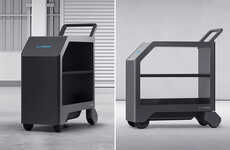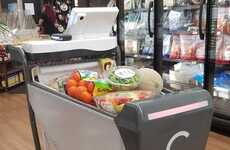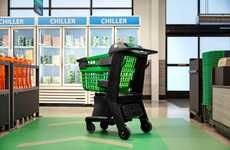
The Drop Cart Adjusts in Depth Depending on the Weight of its Contents
Amelia Roblin — December 3, 2013 — Art & Design
References: red-dot.sg
If you're doing a small or medium scale shop for groceries, it can be a little annoying to work with a large shopping cart. The Drop Cart has been designed to accommodate a range of supermarket purchases with a focus on ergonomics and ease of use.
What Professor Bao Haimo and his team devised was a shopping trolly with an additional inset base. This would be installed with a hydraulic lift in each of its four corners that would cause the panel to rise and fall according to the weight of the products inside. In theory, the more items you put into it, the more volume it provides. The Drop Cart sinks down to the bottom during an extensive food restock operation and gradually lifts to afford a bend-free retrieval of the goods at the checkout.
What Professor Bao Haimo and his team devised was a shopping trolly with an additional inset base. This would be installed with a hydraulic lift in each of its four corners that would cause the panel to rise and fall according to the weight of the products inside. In theory, the more items you put into it, the more volume it provides. The Drop Cart sinks down to the bottom during an extensive food restock operation and gradually lifts to afford a bend-free retrieval of the goods at the checkout.
Trend Themes
1. Ergonomic Shopping Carts - The development of shopping carts designed for ergonomic comfort and ease of use opens opportunities for retailers to enhance the shopping experience and increase customer satisfaction.
2. Weight-responsive Technology - The integration of weight-responsive technology in shopping carts allows for optimized storage space and improved efficiency in restocking operations.
3. Hydraulic Lift Systems - The use of hydraulic lift systems in shopping carts presents opportunities for innovation in the design and functionality of retail equipment.
Industry Implications
1. Retail - Retailers can leverage ergonomic shopping carts and weight-responsive technology to improve customer experience and streamline operations.
2. Supply Chain Management - The use of weight-responsive technology and hydraulic lift systems in shopping carts can enhance efficiency in restocking operations, optimizing supply chain management for retailers.
3. Product Design - The development of ergonomic shopping carts and the integration of hydraulic lift systems create opportunities for product designers to innovate in the retail equipment industry.
2.8
Score
Popularity
Activity
Freshness























